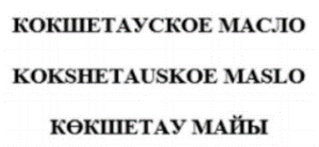|
Description of the quality, reputation and (or) other characteristics of the product, which are largely determined by its geographical origin:
1. Information concerning the relationship of the characteristics of the product with the place of its origin (production)
Milk for the production of Kokshetau butter is supplied from dairy farms in the city of Kokshetau and farms in the Akmola region. Milk is obtained from dairy breeds of cows that feed on the purest meadows of Kokshetau and Akmola region, rich in various grasses, an abundance of nutrients contained in the variety of juicy grasses of the meadows of Kokshetau and Akmola region.
The surroundings of Kokshetau, where dairy cows graze, are also rich in natural clean reservoirs, the number of which exceeds eighty, which is also a distinctive feature of the region and not an unimportant factor for obtaining high-quality and rich in vitamins, nutrients and vitamins milk. At the same time, before entering production, milk undergoes a special selection, by means of laboratory tests, examinations to maintain the taste of useful, natural and nutritious qualities.
2. Description of the quality, reputation and (or) other characteristics of the product (including the source material used for its production, physical, chemical, microbiological, organoleptic or other characteristics), which are largely determined by its geographical origin
Natural butter made from natural milk from environmentally friendly dairy farms in the city of Kokshetau and Akmola region.
3. Description of the method of production of the goods, as well as information on the conditions of storage and transportation, if this has a significant impact on the formation and preservation of the characteristics of the goods
The technological process of producing butter from natural milk. Stages of butter production:
1. Milk acceptance. According to the standards, either grade 1 or grade 2 raw materials can be used to produce the butter. In the latter case, cow's milk may have a specific flavor, some taste defects, as well as a number of other disadvantages. When milk is taken to produce butter, samples are taken from it for laboratory analysis. According to its results, a conclusion is issued on the characteristics of the raw material and permission for its use for the manufacture of butter.
Temperature parameters of raw milk +18+20
Acidity 17-18
Thermal stability 68%-70%
Density 1027-1028
Fat content After undergoing laboratory analysis, raw milk is fed to the intake through a meter. Then it is supplied through cooling and filtration and after that it is supplied for separation.
2. Separation. The milk is sent to the separator. Here it is heated to temperatures of 35-40°C using a tubular pasteurizer. Next, a rotating drum is started, in which the cream is separated by centrifugal force.
3. Normalization. After separation, it is necessary to normalize their fat content. For this purpose, the cream is poured into a special container. If the fat content needs to be increased, fattier cream or buttermilk may be added.
4. Pasteurization. In order to extend shelf life and protect the raw materials for oil production from souring, they should be pasteurized. For this purpose, the cream is heated to 92-95°C and heated at a constant temperature for about 15-20 minutes. This time is enough to destroy most of the microorganisms contained in milk fat, as a result, the shelf life of cream increases by 3-4 times.
5. Cooling and maturation The hot pasteurized mass is quickly cooled to 2-8°C. For this purpose, the same bath is used in which the stages of normalization and pasteurization were carried out. Their production can be accelerated by cooling to the minimum permissible temperatures and constant stirring. After that, the finished cream is fed into the oiler where it passes through rotating drums with cooling and exits the tap into the package.
4. Safety indicators:microbiological, toxicological, radiological
Microbiological indicators
1) Yeast D-50
2) Mold P-50
Toxic elements:
1) Lead 0.1
2) Cadmium 0.03
3) Arsenic 0.1
Pesticides:
1) Hexachlorocyclohexane 0.2
2) DDT and its metabolites 0.2
5. Storage and transportation conditions
Transportation of butter should be carried out by all types of transport in covered vehicles in accordance with the rules for the transportation of perishable goods applicable to the appropriate type of transport; in packaged form — according to GOST 21650, GOST 24597 and other regulatory and technical documentation, as well as in accordance with the requirements for the transportation of dairy products in transport packages approved in accordance with the established procedure.
It is allowed to transport butter in open vehicles at subzero outdoor temperatures with mandatory covering of the outer part of the cargo with a tarpaulin or a material replacing it.
Butter storage at manufacturing enterprises, distribution refrigerators, retail chains and catering establishments, long term storage enterprises should be carried out in accordance with the rules for storing oil at these enterprises.
Butter in consumer containers should be stored at a temperature no higher than minus 3°C and a relative humidity of no more than 80%.
The period of its implementation at the specified temperature, no more than:
10 days from the date of packaging in parchment (or its substitutes); 20 days from the date of packaging in aluminum dated foil, bars; 8 days from the date of packaging in aluminum dated foil with a net weight of 15, 20, 30 g; 15 days from the date of packaging in cups and boxes made of polymer materials.
It is allowed to store butter in consumer containers at a temperature no higher than 6°C for no more than 3 days.
In catering establishments and retail chains, cow's butter should be stored at a temperature of no more than 6°C and a relative humidity of no more than 80%.
The shelf life of peasant butter at - 18 (minus) degrees is 6 months.
Shelf life from the moment of receipt at the specified temperature, no more than 10 days — butter in a monolith.
|

